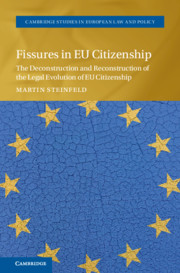 Fissures in EU Citizenship
Fissures in EU Citizenship from Part III - Could the Roof of the Temple Cave in?
Published online by Cambridge University Press: 11 January 2022
This book has attempted to, in effect, go right back to where it all began and examine the case law on free movement in a genealogical sense to expose fissures: latent defects in the project that appear to have come to light fifty years later. Prior to Brexit, such latent defects were never even thought of as such, with the emphasis being, if anything, upon closer integration at all costs. Chapters 1 and 2 outlined a specific way in which the worker was outlined in a (then) Community context, leading to a further set of legal developments in how to conceptualize and legally protect those that did not count as workers.
To save this book to your Kindle, first ensure [email protected] is added to your Approved Personal Document E-mail List under your Personal Document Settings on the Manage Your Content and Devices page of your Amazon account. Then enter the ‘name’ part of your Kindle email address below. Find out more about saving to your Kindle.
Note you can select to save to either the @free.kindle.com or @kindle.com variations. ‘@free.kindle.com’ emails are free but can only be saved to your device when it is connected to wi-fi. ‘@kindle.com’ emails can be delivered even when you are not connected to wi-fi, but note that service fees apply.
Find out more about the Kindle Personal Document Service.
To save content items to your account, please confirm that you agree to abide by our usage policies. If this is the first time you use this feature, you will be asked to authorise Cambridge Core to connect with your account. Find out more about saving content to Dropbox.
To save content items to your account, please confirm that you agree to abide by our usage policies. If this is the first time you use this feature, you will be asked to authorise Cambridge Core to connect with your account. Find out more about saving content to Google Drive.